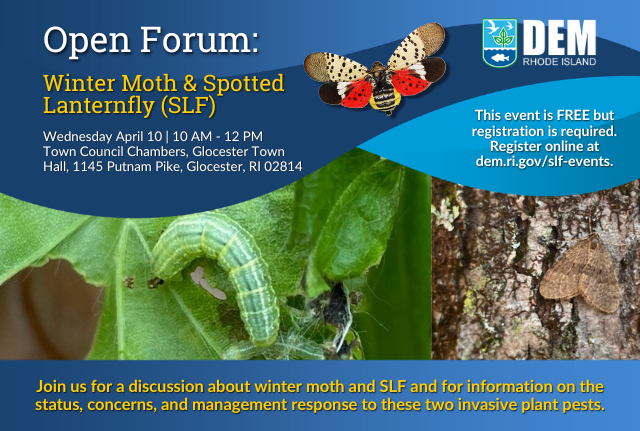Find them, kill them
The Rhode Island Department of Environmental Management (DEM) is reminding Rhode Islanders to remain vigilant for invasive species as their lifecycles progress and they emerge during the spring.
First detected in Pennsylvania in 2014, the SLF has established populations in 14 states, including Rhode Island. SLFs are commonly attracted to the invasive Tree of Heaven (Ailanthus altissima) but also threaten many fruit crops such as apples, apricots, cherries, grapes, hops, nectarines, peaches, and plums as well as native maple, oak, pine, poplar, sycamore, walnut, and willow trees.
DEM, USDA Animal and Plant Health Inspection Service (APHIS), URI’s Biocontrol Lab, and other partners continue to move aggressively to detect and treat scattered SLF populations and egg masses to protect Rhode Island’s farms and forests with the goal of controlling SLF spread and not having to resort to large-scale pesticide treatments.
Spraying for SLFs in Rhode Island started in 2022, and DEM and its partners will continue targeted treatments of trees and bushes infested with SLF with EPA -approved pesticides Bifenthrin and Dinotefuran to limit the spread of this destructive pest.
State-licensed and insured applicators are trained to apply these products safely while protecting the environment and non-target species. The targeted treatments are not large-scale operations, and the project crew typically consists of one-to-two contracted pesticide applicators targeting several of the most infested areas.
SLFs have been detected Smithfield, North Providence, Lincoln, Cumberland, Pawtucket, Providence, Johnston, Cranston and Warwick. DEM staff contact local businesses and property owners before spraying takes place. Spraying will be targeted in transportation areas, highly impacted areas, areas of movement, parks, and areas that are closer to agricultural areas.
DEM is partnering with the Rhode Island Department of Transportation (RIDOT) to gain safe access to highways for further inspection and treatment as these are high risk methods of SLF movement.
DEM is also working with RIDOT to develop educational training
materials for highway and maintenance staff on reporting SLF population
observations throughout their active season. The goal of this outreach is to
provide tools and resources for those most likely to encounter SLF and in turn
bolster the effectiveness of the state’s response.
Winter moth is an invasive defoliator from Europe that was first detected in New England in the early 2000s. The caterpillars of winter moth feed on the leaves of deciduous trees in early spring after larval hatch.
Winter moth caterpillars are lime green with creamy-yellow stripes running lengthwise along each side of the body. Preferred hosts include maple, oak, birch, apple, and blueberry.
Young larvae feed within the leaf and flower buds of their hosts and are often difficult to spot at this stage. Caterpillar frass (or insect droppings) is often easier to observe than the actual caterpillars.
Apple orchards and blueberry farms should monitor their plants and potentially spray for winter moth between mid-April and mid-May. Although the increased winter moth activity during the past autumn has generated increased public interest, the defoliation associated with winter moths isn’t nearly as damaging or widespread as spongy moth (formerly gypsy moth), as winter moth do not completely strip leaves, typically only causing tree mortality if defoliation is repeated year after.
In 2005, a biological control program to control winter moth with the specialist parasitic fly, Cyzenis albicans, was initiated, following widely successful winter moth biocontrol efforts in Nova Scotia with C. albicans.
Releases have been conducted throughout Rhode Island and New England and the flies have been established at almost all release sites throughout the region. Levels of winter moth defoliation have declined in the 15 years since initial releases of the flies, indicating a successful biocontrol program.
While winter moth populations spike from year to year, established populations of C. albicans are expected to build in response to winter moth levels and keep populations in check as DEM continues to conduct aerial surveying to monitor winter moth defoliation.
Later this year, DEM will be initiating a program to collect C.
albicans and redistribute them to areas of winter moth activity in
2025, when the stage of their life cycle is ready for distribution.
Next week, DEM is hosting an open forum to discuss winter moth and SLF and what DEM is doing to address these two priority plant pests and answer public questions.
Speakers DEM Forest Health Program Coordinator
Alana Russell and DEM Cooperative Agricultural Pest Survey Program Coordinator
Cynthia Kwolek will present on the status, concerns, and management response of
these two invasive plant pests. The event is in-person only with no virtual
option. Registration is
required and attendance is limited to 50 people.
WHEN: Wednesday April 10, 10 AM – 12 PM
WHERE: Town Council Chambers, Glocester Town
Hall, 1145 Putnam Pike, Glocester, RI 02814
DEM is also offering four educational training sessions at public libraries throughout Rhode Island in early April for green industry leaders, landscapers, nursery owners, farmers, licensed pesticide applicators, and any members of the public interested in learning about how to prepare and respond to SLF.
Attendees will earn up to two free pesticide credits and will learn how to help protect RI farms and forests by keeping this pest out of vineyards, orchards, and farms that RI’s agricultural economy depends on.
All
four training sessions will cover the same content and will cover strategies
for preparing and responding to this destructive invasive pest. These events
are free, but registration is required. Please visit www.dem.ri.gov/slf-events for more
information and to register.
For more information on DEM programs and initiatives,
visit www.dem.ri.gov. Follow DEM on Facebook, Twitter (@RhodeIslandDEM),
or Instagram (@rhodeisland.dem) for timely updates.
